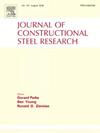带缝耦合钢板剪力墙的实验和数值研究
IF 4
2区 工程技术
Q1 CONSTRUCTION & BUILDING TECHNOLOGY
引用次数: 0
摘要
本研究探讨了带缝隙的耦合钢板剪力墙(C-SPSWS)的抗震性能,这是一种新型侧向承重系统,综合了耦合梁和缝隙钢板的优点。对一个 1:3 比例的四层实验模型进行了循环加载,以评估其滞后行为、破坏模式和能量耗散。通过实验数据验证的数值模型用于分析耦合梁尺寸和长度对系统性能的影响。实验结果表明,主要损坏发生在狭缝壁板和耦合梁上,而边界框架元件基本保持完好。耦合梁的焊缝过早开裂被认为是降低承载能力和能量消耗的主要因素,突出了可靠的梁连接的重要性。该系统表现出稳定的滞后行为、出色的能量耗散和 5.16 的延性比,显示出强大的抗震性能。参数研究表明,增加耦合梁横截面尺寸可提高剪切强度和能量耗散,但如果过大,则会降低延性和材料效率。此外,较短的耦合梁可提高能量耗散和延展性,而较长的耦合梁可提高刚度,但会降低材料效率。为实现强度、延展性和材料效率之间的平衡,建议将耦合梁的设计保持在剪切屈服范围内,最佳耦合度范围为 0.4-0.6。这些发现为抗震建筑中 C-SPSWS 的设计和应用提供了实用指导。本文章由计算机程序翻译,如有差异,请以英文原文为准。
Experimental and numerical investigation of coupled steel plate shear wall with slits
This study investigates the seismic performance of coupled steel plate shear walls with slits (C-SPSWS), a novel lateral load-resisting system that integrates the benefits of coupling beams and slit steel panels. A four-story, 1:3-scale experimental model was subjected to cyclic loading to evaluate its hysteretic behavior, failure modes, and energy dissipation. Numerical models, validated with experimental data, were used to analyze the effects of coupling beam dimensions and lengths on the system performance. The experimental results indicate that primary damage occurs in the slit wall panels and coupling beams, while boundary frame elements remain largely intact. Premature weld cracking in the coupling beams was identified as a major factor reducing the load-carrying capacity and energy dissipation, highlighting the importance of reliable beam connections. The system exhibited stable hysteretic behavior, excellent energy dissipation, and a ductility ratio of 5.16, demonstrating robust seismic performance. Parametric studies reveal that increasing coupling beam cross-sectional dimensions enhances shear strength and energy dissipation but reduces ductility and material efficiency if excessively large. Additionally, shorter coupling beams improve energy dissipation and ductility, while longer beams increase stiffness but compromise material efficiency. An optimal degree of coupling range of 0.4–0.6, with coupling beams designed to remain in the shear-yielding range, is recommended for achieving a balance between strength, ductility, and material efficiency. These findings provide practical guidance for the design and application of C-SPSWS in seismic-resistant buildings.
求助全文
通过发布文献求助,成功后即可免费获取论文全文。
去求助
来源期刊

Journal of Constructional Steel Research
工程技术-工程:土木
CiteScore
7.90
自引率
19.50%
发文量
550
审稿时长
46 days
期刊介绍:
The Journal of Constructional Steel Research provides an international forum for the presentation and discussion of the latest developments in structural steel research and their applications. It is aimed not only at researchers but also at those likely to be most affected by research results, i.e. designers and fabricators. Original papers of a high standard dealing with all aspects of steel research including theoretical and experimental research on elements, assemblages, connection and material properties are considered for publication.
 求助内容:
求助内容: 应助结果提醒方式:
应助结果提醒方式:


